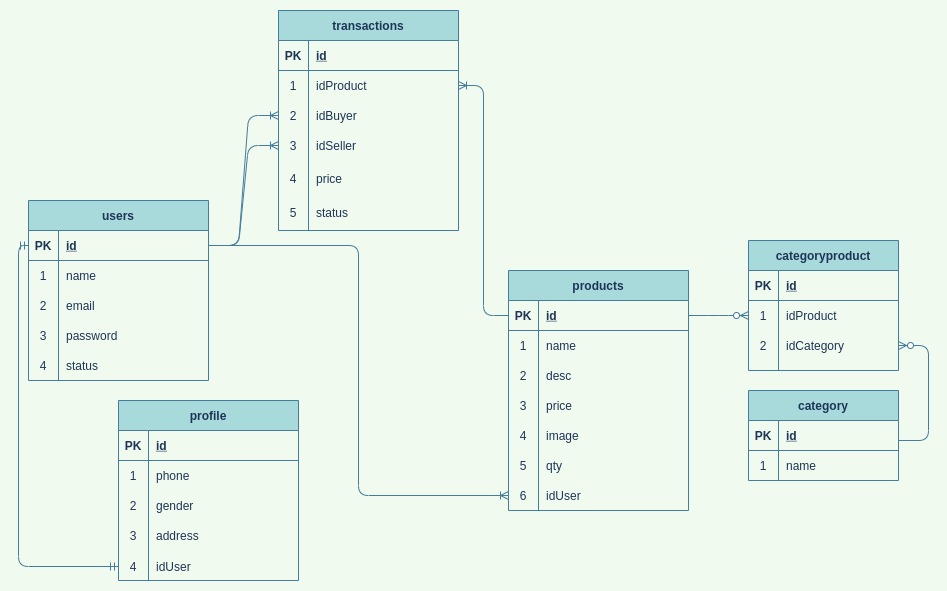-
Create
user.gofile insidemodelsfolder, and write this below codeFile:
models/user.gopackage models import "time" type User struct { ID int `json:"id"` Name string `json:"name" gorm:"type: varchar(255)"` Email string `json:"email" gorm:"type: varchar(255)"` Password string `json:"-" gorm:"type: varchar(255)"` CreatedAt time.Time `json:"-"` UpdatedAt time.Time `json:"-"` } type UsersProfileResponse struct { ID int `json:"id"` Name string `json:"name"` } func (UsersProfileResponse) TableName() string { return "users" }
-
Create
profile.gofile insidemodelsfolder, and write this below codeFile:
models/profile.gopackage models import "time" type Profile struct { ID int `json:"id" gorm:"primary_key:auto_increment"` Phone string `json:"phone" gorm:"type: varchar(255)"` Gender string `json:"gender" gorm:"type: varchar(255)"` Address string `json:"address" gorm:"type: text"` UserID int `json:"user_id"` User UsersProfileResponse `json:"user"` CreatedAt time.Time `json:"-"` UpdatedAt time.Time `json:"-"` } // for association relation with another table (user) type ProfileResponse struct { Phone string `json:"phone"` Gender string `json:"gender"` Address string `json:"address"` UserID int `json:"-"` } func (ProfileResponse) TableName() string { return "profiles" }
-
Create
product.gofile insidemodelsfolder, and write this below codeFile:
models/product.gopackage models import "time" type Product struct { ID int `json:"id" gorm:"primary_key:auto_increment"` Name string `json:"name" form:"name" gorm:"type: varchar(255)"` Desc string `json:"desc" gorm:"type:text" form:"desc"` Price int `json:"price" form:"price" gorm:"type: int"` Image string `json:"image" form:"image" gorm:"type: varchar(255)"` Qty int `json:"qty" form:"qty"` UserID int `json:"user_id" form:"user_id"` User UsersProfileResponse `json:"user"` Category []Category `json:"category" gorm:"many2many:product_categories"` CategoryID []int `json:"category_id" form:"category_id" gorm:"-"` CreatedAt time.Time `json:"-"` UpdatedAt time.Time `json:"-"` } type ProductResponse struct { ID int `json:"id"` Name string `json:"name"` Desc string `json:"desc"` Price int `json:"price"` Image string `json:"image"` Qty int `json:"qty"` UserID int `json:"-"` User UsersProfileResponse `json:"user"` Category []Category `json:"category" gorm:"many2many:product_categories"` CategoryID []int `json:"category_id" form:"category_id" gorm:"-"` } type ProductUserResponse struct { ID int `json:"id"` Name string `json:"name"` Desc string `json:"desc"` Price int `json:"price"` Image string `json:"image"` Qty int `json:"qty"` UserID int `json:"-"` } func (ProductResponse) TableName() string { return "products" } func (ProductUserResponse) TableName() string { return "products" }
-
Create
category.gofile insidemodelsfolder, and write this below codeFile:
models/category.gopackage models import "time" type Category struct { ID int `json:"id" gorm:"primary_key:auto_increment"` Name string `json:"name"` CreatedAt time.Time `json:"-"` UpdatedAt time.Time `json:"-"` }
-
Create
transaction.gofile insidemodelsfolder, and write this below codeFile:
models/transaction.gopackage models import "time" type Transaction struct { ID int `json:"id" gorm:"primary_key:auto_increment"` ProductID int `json:"product_id"` Product ProductResponse `json:"product"` BuyerID int `json:"buyer_id"` Buyer UsersProfileResponse `json:"buyer"` SellerID int `json:"seller_id"` Seller UsersProfileResponse `json:"seller"` Price int `json:"price"` Status string `json:"status" gorm:"type:varchar(25)"` CreatedAt time.Time `json:"-"` UpdatedAt time.Time `json:"-"` }
-
Create
authfolder, inside it Createauth_request.goand write this below codeFile:
dto/auth/auth_request.gopackage authdto type AuthRequest struct { Name string `gorm:"type: varchar(255)" json:"name"` Email string `gorm:"type: varchar(255)" json:"email"` Password string `gorm:"type: varchar(255)" json:"password"` }
-
Create
productfolder, inside it Createproduct_request.goand write this below codeFile:
dto/product/product_request.gopackage productdto type ProductRequest struct { Name string `json:"name" form:"name" gorm:"type: varchar(255)"` Desc string `json:"desc" gorm:"type:text" form:"desc"` Price int `json:"price" form:"price" gorm:"type: int"` Image string `json:"image" form:"image" gorm:"type: varchar(255)"` Qty int `json:"qty" form:"qty" gorm:"type: int"` UserID int `json:"user_id" gorm:"type: int"` CategoryID int `json:"category_id" form:"category_id" gorm:"type: int"` }
-
Create
profilefolder, inside it Createprofile_request.goand write this below codeFile:
dto/profile/profile_request.gopackage profiledto import "dumbmerch/models" type ProfileResponse struct { ID int `json:"id" gorm:"primary_key:auto_increment"` Phone string `json:"phone" gorm:"type: varchar(255)"` Gender string `json:"gender" gorm:"type: varchar(255)"` Address string `json:"address" gorm:"type: text"` UserID int `json:"user_id"` User models.UsersProfileResponse `json:"user"` }
-
Inside
repositoriesfolder, createrepository.gofile, and write this below codeFile:
repositories/repository.gopackage repositories import "gorm.io/gorm" type repository struct { db *gorm.DB }
*
repositorystruct move fromuser.gofile
